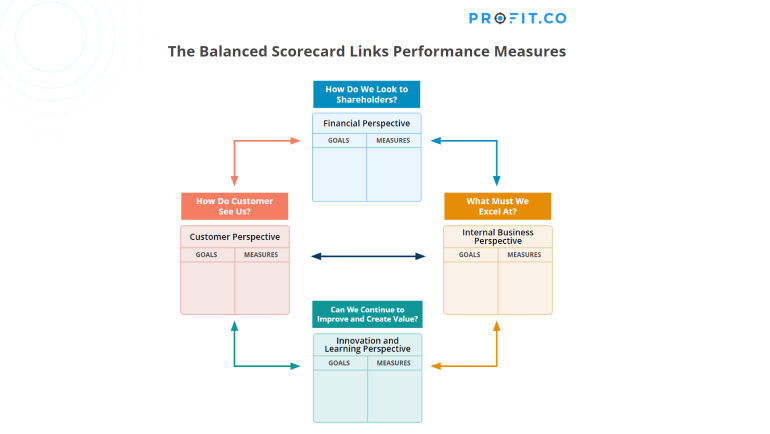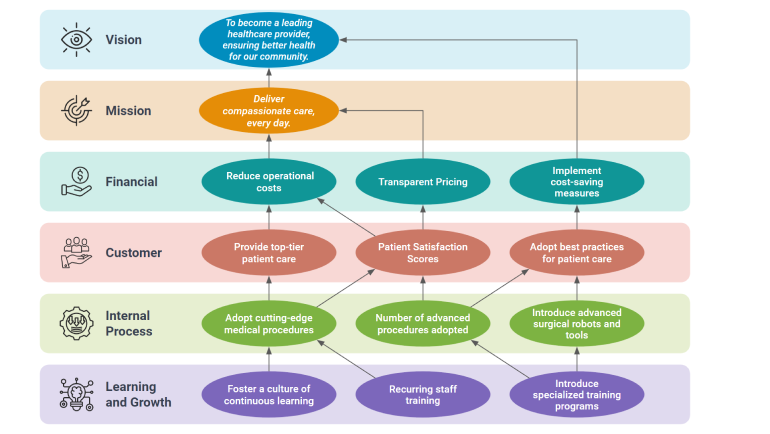When it comes to gauging an organization’s health, the financial bottom line is often the go-to metric. But what if there’s more to the story?
The Balanced Scorecard (BSC), is a revolutionary tool that offers a broader perspective on performance. Through the BSC, businesses can translate their mission and vision into actionable indicators spanning customer satisfaction, daily operations, staff development, and of course, finances. The meaning of the Balanced Scorecard, as its name suggests, provides a balanced view of an organization’s performance. It goes beyond just financial numbers, emphasizing that elements like continuous learning, efficient processes, and a focus on customers are equally essential for a business’s long-term financial well-being. It also ensures that every task performed today is in sync with tomorrow’s goals.
Definition of Balanced Scorecard
The Balanced Scorecard (BSC) is a strategic management tool that provides a comprehensive view of an organization’s performance by measuring it from four key perspectives: financial, customer, internal processes, and learning and growth. It goes beyond traditional financial metrics, aiming to give a more holistic view of an organization’s health and strategic alignment.
The History of the Balanced Scorecard
Robert S. Kaplan and David P. Norton introduced the Balanced Scorecard in 1992. They believed that while old businesses focused mainly on financial numbers, modern companies needed a broader view to address their varied goals and challenges.
The Benefits of the Balanced Scorecard
The Balanced Scorecard (BSC) lays out goals tied to strategic priorities in finance and non-finance. The next step is figuring out how to measure progress. It plans specific tasks or projects to meet those goals only after that. This unique sequence ensures that every project directly supports the strategy and doesn’t waste resources.
The Balanced Scorecard (BSC) is a tool companies use as a strategic planning and management tool for several key reasons, such as:
- Communication
It clearly states the company’s goals, ensuring everyone understands the objectives.
- Alignment
The BSC ensures that daily tasks and activities directly support the company’s overarching strategy.
- Prioritization
It helps organizations determine which projects, products, or services should be focused on for strategic success.
- Monitoring
With BSC, companies can regularly check their progress, ensuring they’re on track to achieve their strategic targets.
A mere 7% of employees today fully understand their company’s business strategies and what’s expected of them in order to help achieve company goals
The Four Perspectives of The Balanced Scorecard
Financial
How do we look to our shareholders? This touches upon revenue, profitability, and growth metrics. Links lower-level objectives to guide investments.
Customer
How do customers see us? It delves into customer satisfaction, loyalty, and retention rates. Emphasizes understanding customer needs.
Internal process
What processes must we excel at? This evaluates the efficiency of business operations and the quality of products/services. Highlights areas for innovation.
Learning and growth
Can we continue to improve and innovate? This looks into employee training, corporate culture, and other avenues for organizational growth. Targets improvement and value creation.
For each perspective, goals are defined, after which measures are set to track progress towards those goals. Subsequently, initiatives (actions to achieve the goals) are outlined, and success indicators are identified. The end product, the BSC, serves as both a performance monitor and a strategic guide, ensuring alignment of day-to-day operations with broader organizational aspirations.

Who uses the Balanced Scorecard?
Companies everywhere, from businesses to nonprofits to governments, use the balanced
scorecard approach. It’s a favorite tool of many top companies in the US, Europe, Asia, and beyond. It’s so popular that a Bain & Co survey ranked it among the top ten management tools globally.
Real-world Examples of Companies That Use the Balanced Scorecard Framework
The following Balanced Scorecard examples show how diverse companies spanning various industries employ the balanced scorecard framework tailored to their specific needs and strategic objectives.
Apple Computer
In the 1990s, Apple used the balanced scorecard to shift its emphasis from being solely a product-focused company to becoming a customer-centric one. They introduced customer satisfaction metrics and began conducting global surveys to track key market segments. They also emphasized core competencies like user-friendly interfaces, powerful software architectures, and effective distribution systems.
J.D. Power & associates
While they’re more known for providing scorecards, J.D. Power gives companies in various industries a balanced scorecard. They measure and report on customer satisfaction, product quality, and loyalty, offering industry benchmarks.
Tata Consultancy Services (TCS) – Library & Information Services function (LIS):
Started in 1970, the LIS function used the BSC approach to track its performance. They regularly evaluated their librarian’s knowledge to align with business domain expertise and tracked the network growth of their libraries.
Volkswagen
The automobile manufacturer implemented a balanced scorecard to align its strategy with operations and check if they’re achieving its goals. They used it to improve product quality, enhance customer relations, and streamline internal processes.
Tesco
The UK-based retail giant Tesco used the balanced scorecard approach to redefine their strategy in the early 2000s. They focused on four key perspectives: the customer perspective (like customer satisfaction and loyalty), operations (store formats and stock levels), people (employee development and training), and finance (profit margins, sales growth).

How to Create a Balanced Scorecard?
Creating a balanced scorecard (BSC) is a strategic activity that helps organizations align their day-to-day activities with their broader goals and objectives. Here’s a step-by-step guide:
Ready to start your KPI journey today?
Define your organization’s vision and strategy.
Start by outlining your organization’s vision, mission, and main strategic goals.
Identify the four key perspectives
- Financial Perspective: Understand how financial success looks for your organization.
- Customer Perspective: Focus on customer needs and satisfaction.
- Internal Process Perspective: Examine your core processes and operational efficiency.
- Learning and Growth Perspective: Look into your organizational growth, learning, and innovation.
Develop objectives for each perspective.
These can range from boosting annual revenue (financial) and enhancing customer loyalty (customer), to streamlining product delivery (internal process) and improving employee training programs (learning and growth).
Choose metrics and KPIs
Tangible KPIs might include aiming for a 15% ROI (financial), increasing customer retention by 10% (customer), reducing product delivery time by 20% (internal process), or amplifying training sessions by 50% (learning and growth).
Set targets for each KPI
Decide on specific, measurable targets for each KPI to ensure they are aligned with your strategic goals and are realistic yet challenging.
Identify Initiatives to achieve targets.
To boost revenue, consider diversifying the investment portfolio. Enhance customer loyalty through a loyalty program, streamline product delivery with a new inventory management system, and improve employee training by introducing an e-learning platform. Each initiative directly supports specific objectives and KPIs, creating a focused approach to strategic growth.
Link initiatives and KPIs to budget and resources.
Allocate necessary resources (human resources, money, or technology) for each initiative to ensure effectiveness.
Implement the BSC
Deploy the BSC throughout the organization. Ensure everyone comprehends the significance of the BSC and their roles in realizing the broader goals.
Monitor, Report, and Review
Consistently track progress on KPIs. Utilize the BSC for routine strategic evaluations, modifying objectives, KPIs, or initiatives based on performance or any shifts in the organization’s strategy or the wider environment.
Iterate and Improve
Remember, the BSC isn’t static. As your organization grows and evolves, frequently revisit and tweak your scorecard to make sure it stays aligned with your latest strategy and objectives.
The strength of the BSC doesn’t just lie in its design but in its regular use, continuous evaluations, and the dedication of the entire organization to its strategic objectives.
| Perspective | Strategic Objective | Objectives | KPIs | Initiatives |
|---|---|---|---|---|
| Financial | Ensure financial sustainability to fund the rescue mission adequately. | Raise sufficient funds for operations. | Achieve 95% or above of the annual fundraising target. | Launch bi-annual online fundraisers with influencers and local businesses. |
| Customer | Assess the impact and effectiveness of the rescue mission. | Improve the quality of rescue services. | Achieve a 4.5/5 rating from beneficiaries on rescue service quality. | Introduce a post-rescue feedback system for beneficiaries. |
| Internal Process | Optimize internal processes to ensure successful and timely rescue missions. | Streamline the rescue process. | Reduce rescue response time to under 30 minutes from the moment of notification. | Implement a real-time tracking system for faster deployment. |
| Learning and Growth | Build the organization’s capacity to innovate and adapt to changing circumstances. | develop staff and volunteer skills. | Achieve 95% training completion for staff and volunteers annually. | Introduce monthly skill-building workshops and e-learning modules. |
What is a Strategy Map?
A strategy map is a visual tool used to articulate and communicate an organization’s strategic goals and show how they connect to one another. It’s often associated with the Balanced Scorecard (BSC) framework, which is used to manage and measure an organization’s strategy
Below is an example of a strategy map constructed specifically for the healthcare industry based on the traditional perspectives of the Balanced Scorecard showcasing the linkage between them and the specific objectives.

Conclusion
Over the years, the Balanced Scorecard has proven invaluable for organizations seeking to achieve a competitive advantage, drive innovation, and foster continuous improvement. In conclusion, the Balanced Scorecard is a testament to the idea that “what gets measured gets managed,” emphasizing the necessity of a balanced approach to organizational success.
Moreover, the use of Balanced Scorecard Software can significantly enhance the efficiency and effectiveness of implementing the Balanced Scorecard, ensuring that all key performance indicators are tracked and managed seamlessly.
To learn more about achieving strategic goals for your organization.
Related Articles
-
5 Essential Dashboards Every Business Leader Should Use
Business leaders, are you steering your strategy with crystal-clear insights—or flying blind? Profit.co's dashboards are designed to make your decisions... Read more
-
What is a Succession Development Plan in Profit.co?
In the corporate world, the continuity of performance and leadership among employees is paramount. The expertise and internal understanding gained... Read more
-
Why Does Your Organization Need an Individual Development Plan (IDP) to Grow?
Introduction If you want to stay up to date on the job market, tackle the demands of today’s workplace, and... Read more
-
Performance Competencies in Profit.co: Uses, Levels, & Examples
Evaluating Performance Performance management is one of the key pillars of a successful organization. Delivering useful feedback to employees and... Read more

